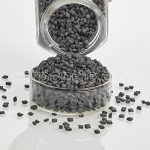
Heat Resistance PPA CF30 Composites
PPA CF30 are mainly formulated for high demands that require high stiffness & good impact strength like metal substitution or other structural applications. Positive characteristics of PPA CF30 composites include improved impact strength, elastic modulus & material strength over a wide temperature range from below room temperature to high temperature. They have been proved to provide excellent creep performance and fatigue performance, outstanding dimensional stability, and exhibit satisfying surface smoothness.
- Product Name: PPA CF30 Composites
- Formula: Carbon Fiber - 30%
- Process Molding: Injection/Extrusion Molding
- Manufacturer: Yes
- OEM/ODM: Acceptable
What’s PPA CF30?
PPA CF series such as PPA CF30 have the characteristics of high tensile strength, high flexural modulus, creep resistance, and good dimensional stability. They have strong mechanical properties even under high temperature and high humidity conditions, and show good Resistant to gasoline, grease and coolants.
Advantages and Disadvantages
Advantage:
1. It has strong tensile strength under high temperature and high humidity conditions;
2. High flexural modulus and creep resistance;
3. Resistant to gasoline, grease and coolant;
4. Strong dimensional stability under high temperature conditions;
5. High wear resistance;
Limitations:
1. It has certain hygroscopicity and needs to be dried;
2. The injection molding processing temperature is high;
PPA CF series materials have higher temperature resistance than ordinary engineering plastics. Their continuous operating temperature ranges from 120°C to 185°C (248°F to 365°F), and the heat distortion temperature (HDT) even exceeds 300°C. (572°F), is a series of engineering plastics with very superior performance.
Under high temperature conditions, PPA CF series materials can maintain high strength and rigidity, and their performance is better than some nylon materials. Moreover, the moisture absorption rate of PPA CF series materials is very low, and the humid environment will not affect the performance and maintenance of material performance.
Product Image
Availability: Xiamen, China Forms: Pellets Filler/Reinforcement: Carbon Fiber, 30% Filler by Weight Additive: PTFE Lubricant(10%) Features: Lubricated, Good Wear Resistance, High Heat Resistance and Low Friction Information provided by Carbon (Xiamen) New Material Co., Ltd.

Frequently Asked Questions
Carbon (Xiamen) New Material Co., Ltd. aims to provide buyers with "one-stop" worry-free high-quality services. Here you can find all information about carbon fiber engineering plastics. If you still have questions, please send us an email for consultation!
-
How can I contact the manufacturer of a product that interests me?
When you find a product you are interested in, you can contact the manufacturer directly by sending an email and we will get back to you as soon as possible.
-
How do I find the products that interest me?
All you need to do is enter the keyword, product name in the search window and press the Enter key on your keyboard. Your search results page will then be displayed. You can also search within the product category pages on the home page. Each category is divided into subcategories, allowing you to refine your search and find products that interest you.
-
Where will I find a buying guide?
Please contact our after-sales service directly and we will provide you with a comprehensive operating guide.
-
What are CF Reinforced Thermoplastic Composites?
CF Reinforced Thermoplastic Composites are materials where carbon fibers are incorporated into a thermoplastic matrix. They combine the strength and stiffness of carbon fibers with the processability and recyclability of thermoplastics. For instance, they are used in automotive parts like bumper beams.
-
What are the benefits of CF Reinforced Thermoplastic Composites over traditional composites?
The key benefits include faster production cycles, easier recyclability, and better impact resistance. They also offer design flexibility. An example is in the manufacturing of consumer electronics casings where complex shapes can be achieved more easily.
-
How are CF Reinforced Thermoplastic Composites processed?
Common processing methods include injection molding, extrusion, and compression molding. Injection molding is widely used for mass production. For example, in the production of small components for the medical industry.
-
What industries use CF Reinforced Thermoplastic Composites?
They are utilized in aerospace, automotive, medical, and sports equipment industries. In aerospace, they can be found in interior components. In the medical field, they might be used in prosthetics.
-
How does the carbon fiber content affect the properties of the composites?
Higher carbon fiber content generally leads to increased strength and stiffness but may reduce ductility. A moderate content is often balanced for specific applications. For example, a higher content might be preferred in structural parts of a race car.
-
What are the challenges in using CF Reinforced Thermoplastic Composites?
Challenges include higher material costs, complex processing equipment requirements, and ensuring uniform fiber dispersion. Issues with adhesion between the fibers and the matrix can also arise. An example is in achieving consistent quality in large-scale production.


























